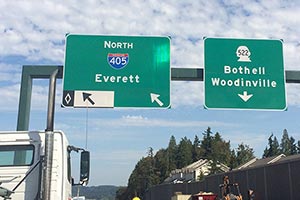Potential Expansion of Tolling Program Concerns Washington Trucking Group

A pilot tolling program in Washington state is working so well, in the view of the state’s Department of Transportation, that it might be expanded, a possibility that concerns Washington Trucking Associations.
Although trucks aren’t allowed to use the high-occupancy tolling lanes on the 17-mile stretch of Interstate 405 that went into effect Sept. 27, that won’t necessarily be the case on future toll roads. The Washington State Department of Transportation is preparing an environmental impact statement to evaluate the effects of tolling I-90 between I-5 in Seattle and I-405 in Bellevue.
“It’s costing up to 30-minute delays per truck per day,” said WTA Vice President Sheri Call, who noted that trucks aren’t even eligible to use the HOT lanes. “That adds up to quite a bit of expense. There’s a planned extension of the 405 HOT lanes south to I-5 from downtown Bellevue, so the legislators from those districts are raising concerns now before they extend the problem.”
WSDOT spokesman Ethan Bergerson said the 14-year, $15 billion transportation funding plan that became law last year doesn’t preclude adding tolls to the ones on I-405 and state Route 167 south of Bellevue, as well as on the 520 and Tacoma Narrows bridges.
During the HOT lanes’ first three months, they generated 2.75 million trips and revenue of $4.7 million, as well an average time savings of 14 minutes for drivers in the regular lanes thanks in part to an additional lane that WSDOT added going south. However, slightly longer travel times northbound during the afternoon rush north of Route 522 prompted Gov. Jay Inslee on Feb. 16 to ask the agency to try to reduce congestion.
“Six-hundred thousand [unique visitors per month] have voted with their feet and have already used these toll lanes, but we have also experienced new choke points . . . and we are hearing real frustration from real drivers,” said Inslee, who suggested canceling the tolls during evening off-peak hours, weekends and holidays. “Tolling during those times is not necessary to achieve the ends of this project, which are to reduce congestion and improve commuting and travel times.”
Inslee’s announcement drew a backhanded compliment from state Sen. Curtis King, chairman of the Transportation Committee, who voted for adding the tolls but only with the two-year sunset provision.
“I was pleased to see the governor finally recognized there was a problem,” King said. “He’s offered some solutions, some of which [halting tolls on weekends and holidays] came out of a bill by a Republican from that district [Andy Hill], and some were suggested by Democrats in the House and Senate. It remains to be seen if any of these will solve the problem. I’m willing to give it a chance, but so far I would say it hasn’t worked very well.”
Any changes would have to be approved by the Legislature, which created the pilot program. Toll revenues are dedicated to future investment in the I-405 corridor.
“We want to give the program time to work [six months to a year], but we’re seeing positive initial results,” Bergerson said, noting that WSDOT will consider the program a success if it breaks even and the express lanes move 45 mph at least 90% of the time. “Hopefully this will continue.”
King said he won’t support keeping the tolls after their September 2017 expiration if they are earning money for the state but costing drivers, including those in trucks.
“We are a freight-oriented state,” King said. “We are bringing products from the east side of the state down to our ports, and [the I-405] corridor is important in doing that. Trucks need to get to their destinations as quickly and effectively as they can.”

